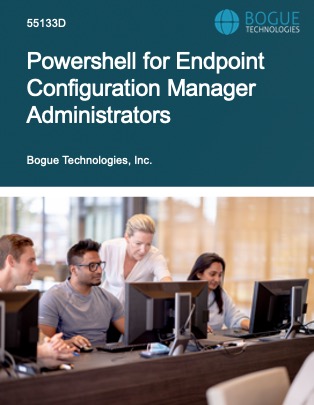
PowerShell for Microsoft Endpoint Configuration Manager Administrators Courseware (55133D)
This three-day instructor-led course provides students with the knowledge and skills needed to use PowerShell for Endpoint Configuration Manager (ECM) administration. In this course, students learn how to access the PowerShell cmdlets included with ECM 2203 and use them to perform configuration tasks for a primary site. Individual cmdlets will be used in working with objects such as Boundaries, Boundary Groups, Collections, Software Deployment, Patching, Compliance Settings, OSD Task Sequences, and many others. Basic scripting will also be covered so that students can learn how to put PowerShell to use when working with large sets of objects.
Benefits
After completing this course, students should be able to:
- Explain Microsoft Endpoint Configuration Manager 2203 concepts
- Configure discovery methods
- Create and manage collections
- Create and manage boundaries and boundary groups
- Install and manage the Configuration Manager client
- Deploy software applications
- Deploy software updates
- Configure compliance settings
- Configure Operating System Deployment objects
- Manage primary site properties
- Delegate management authority for the site
- Configure Endpoint Protection
- Monitor site system components
- Write scripts to automate Configuration Manager tasks
Outline
- Module 1: Review of Endpoint Configuration Manager Concepts
- Lesson 1: Architecture of a Microsoft Endpoint Configuration Manager 2203 Installation
- Lesson 2: Managing Assets
- Lesson 3: Content Delivery and Management
- Lesson 4: Security, Monitoring and Remote Management
- Lab: Reviewing a Primary Site Installation
- Module 2: Managing Resources
- Lesson 1: Implementing Discovery
- Lesson 2: Organizing Resources with Collections
- Lesson 3: Working with Boundaries
- Lab: Configuring Discovery, Collections and Boundaries
- Module 3: Working with Clients
- Lesson 1: Installing the Configuration Manager Client
- Lesson 2: Managing Client Settings
- Lesson 3: Managing Client Operations
- Lesson 4: Monitoring Client Status
- Lab: Utilizing PowerShell to Manage Clients
- Module 4: Distributing Software
- Lesson 1: Configure the Software Distribution Components
- Lesson 2: Working with Distribution Points
- Lesson 3: Creating Content for Distribution
- Lesson 4: Deploying Software Applications
- Lab: Using Commands to Publish Software
- Module 5: Updating Systems with WSUS and ECM
- Lesson 1: Integrating Configuration Manager and WSUS
- Lesson 2: Managing Updates through Software Update Groups
- Lesson 3: Creating and Deploying Update Packages
- Lesson 4: Working with Automatic Deployment Rules
- Lab: Using Configuration Manager Commands to Manage Software Updates
- Module 6: How PowerShell Can Manage Compliance Settings
- Lesson 1: Creating Compliance Settings Objects
- Lesson 2: Deploying Configuration Baselines
- Lab: How PowerShell Can Manage Compliance
- Module 7: Configuring Operating System Deployment Objects
- Lesson 1: Preparing the OSD Environment
- Lesson 2: Working with Task Sequences
- Lab: Operating System Deployment with Windows PowerShell
- Module 8: Working at the Site Level
- Lesson 1: Modify the Site
- Lesson 2: Adding Site System Roles
- Lesson 3: Adding a Secondary Site
- Lab: Modifying Site Settings
- Module 9: Security and Monitoring
- Lesson 1: Configuring Role Based Administration
- Lesson 2: Implementing Endpoint Protection
- Lesson 3: Configuring Monitoring Options
- Lab: Implementing Security and Monitoring
- Module 10: Using PowerShell Scripting to Automate ECM Tasks
- Lesson 1: Review of Scripting Constructs
- Lesson 2: Introduction to the Configuration Manager WMI Classes
- Lab: Writing Scripts for Configuration Manager Activities
Required Prerequisites
- Windows Server 2022 operating system
- Windows 11 operating system
- Active Directory Domain Services
- Familiarity with the Microsoft Endpoint Configuration Manager 2203 features
- Use of the Configuration Manager console
Useful Prerequisites
- Basic PowerShell command syntax and scripting constructs
License
LicenseRequest More InformationRequest Trainer Evaluation CopyWhat is Included?
- Student Manual
- Extra Trainer Files
- PowerPoint Presentation
*Labs must be purchased from the lab provider.